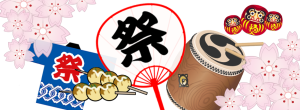Justin’s Japan: AnimeNEXT Welcomes Idol Luna Haruna
By JQ magazine editor Justin Tedaldi (CIR Kobe-shi, 2001-02) for Shukan NY Seikatsu. Visit his Examiner.com Japanese culture page here for related stories.
Fans of manga, anime, cosplay and J-pop are eagerly awaiting AnimeNEXT, the largest independently organized anime convention in the New York/New Jersey metropolitan area.
The annual event, which will be held at the Garden State Exhibit Center in Somerset from June 6-8, will feature the debut East Coast performance of Tokyo-based singer and recording artist Luna Haruna, whose songs have appeared in the anime series “Fate/Zero,” “Sword Art Online” and “Monogatari.”
“Last year was Luna’s first time in the States and she made a successful U.S. debut performance at Sakura-Con in Seattle,” says Tomo Tran, a publicist for Sony Music Entertainment (Japan). “Since her debut two years ago, Luna has released five singles and one full album, which have ranked in the top 20 on the Oricon music chart.”
An amateur model and a finalist at the fourth All-Japan Anime Song Grand Prix, Haruna headlined concerts in Tokyo and Osaka earlier this spring.
“Since she really enjoyed her time here last year, we (SMEJ) felt it was great for her to come back and to continue her success,” Tran says. “I hope that fans are pumped up and ready to welcome Luna Haruna this summer!”
Other musicians scheduled to perform at AnimeNEXT include J-punk band ROOKiEZ is PUNK’D and Chipocrite, who crafts unique soundscapes from original Nintendo Game Boys.
For more information, visit www.animenext.org.
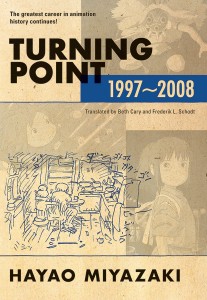
“With wit and humor, Miyazaki offers insight from his long career with every turn of the page. Like an unforgettable sunset or the first time a cooking experiment came out well, he discusses experiences that leave you unexpectedly changed.” (VIZ Media)
By Alexis Agliano Sanborn (Shimane-ken, 2009-11) for JQ magazine. Alexis is a graduate of Harvard University’s Regional Studies—East Asia (RSEA) program, and currently works as an executive assistant at Asia Society in New York City.
I consider myself an aficionado of director and animator Hayao Miyazaki and Studio Ghibli. Having seen his work countless times, visited the museum in Tokyo and done a fair amount of supplemental reading, I figured Turning Point—a collection of Miyazaki interviews and articles spanning 1997 through 2008 and newly translated by Beth Cary and Frederik L. Schodt—would probably be a rehash of the similar. I presumed it would be a book for Japan or anime specialists. On the back cover there’s even a quote from the L.A. Times: “Essential reading for anyone interested in Japanese or Western animation.” However, this statement is entirely too narrow and ultimately misleading.
In fact, the book (which is a sequel to Starting Point: 1979-1996, also translated by Cary and Schodt and now available in paperback) is less about animation and Japan than it is the human condition and those existential questions that keep you awake at night. Miyazaki, at one moment reserved and the other candid, plunges fearlessly into complex, introspective and intellectual issues about human’s relationship with education, child-rearing, philosophy, history, art, environmentalism and war (to name a few).
He does this with a sprinkle of romanticism and a dusting with realism. Using his seemingly continual dissatisfaction with the world, Miyazaki aims to positively spark change and inspire. He insists that his films are not just flights of fancy; rather, he makes them to motivate the next generation to improve the world. “Children learn by experiencing…it is impossible to grow up without being hurt,” he writes. “Experiences like: accepting the duality of human nature, the importance of grit, conviction, and perseverance, and respecting nature and the land….For children willing to start, our films become powerful encouragement.”
JQ Magazine: Concert Review—Yoshiki Classical World Tour Dazzles San Francisco with Surprise X Japan Guest

“The night offered something for everyone in Yoshiki’s ability to merge and bring together different genres and listeners and touch the collective beating heart therein.” (Shirong Gao)
By Shirong Gao (Shiga-ken, 2005-07) for JQ magazine. A member of JETAA Northern California, Shirong is a graphic designer, Illustrator, and breakfast food lover who worked in a Japanese countryside as seen only in Studio Ghibli movies. For more, visit gaoshirong.com.
Every night, as a child drifting off to sleep, I looped a rock ballad. My personal lullaby. A song by multi-million-selling heavy metal band X Japan, the Rising Sun’s answer to KISS. Yet not even in dreams did I see myself growing up to one day meet its leader, Yoshiki, and witness how far he’s come in his career.
A classically trained musician turned rock legend, Yoshiki has now returned to his more refined roots, embarking on a world tour of Yoshiki Classical concerts featuring music from the eponymous solo album released last year in collaboration with talents the likes of Beatles producer Sir George Martin and the London Philharmonic Orchestra.
On April 28, Davies Hall, home to the San Francisco Symphony, was packed on a Monday night to host only the second date of Yoshiki’s tour following its debut in Costa Mesa three days prior. “Definitely a different scene from a typical classical concert,” commented attendee Arisa Takahashi (Nara-ken CIR, 1991-92), who has also performed at the hall as part of the Sing Out, Davies! choral workshop. “There were people with blue hair, dressed in their frilly Lolita finery, sitting alongside classical music attendees.”
Justin’s Japan: Nippon in New York — Miyazaki, Godzilla, Tribeca Film Festival, Sakura Matsuri
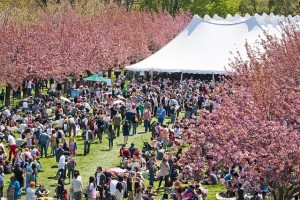
New York’s 33rd annual Sakura Matsuri will be held at Brooklyn Botanic Garden April 26-27. (Mike Ratliff)
By JQ magazine editor Justin Tedaldi (CIR Kobe-shi, 2001-02) for Examiner.com. Visit his Japanese culture page here for related stories.
Spring has sprung in the Big Apple, and that means one thing: a new season of sounds, colors, and spectacular performing arts to match the blossoming sakura trees throughout the city.
This month’s highlights include:
Tuesday, April 8
Turning Point: 1997-2008 by Hayao Miyazaki
MSRP $29.99, $34.99
The companion second volume to the earlier chronicleStarting Point: 1979-1996 (also new in paperback),Turning Point is an insightful collection of essays, interviews, memoirs, and illustrations from legendary animation director Hayao Miyazaki. The new title covers the critical stage in the legendary director’s career when his animated films for Studio Ghibli such as Princess Mononoke, Spirited Away, and Ponyo began to garner a significant international audience. Turning Point follows Miyazaki as his grand vision continued to mature, cinema-lovers worldwide discovered and embraced his creations, and prominent film critics such as Roger Ebert delivered tremendous acclaim for the director’s films. Bringing us up to the present is The Art of The Wind Rises, which captures the art of the film from conception to production, featuring in-depth interviews with the creative team from Miyazaki’s latest—and supposedly final—Academy Award-nominated epic.
April 8-13, 8:00 p.m. and 10:30 p.m.
Gary Burton & Makoto Ozone Duets
Blue Note Jazz Club, 131 West Third Street
$20, $35
Born in Kobe to a jazz organist father, Makoto Ozone came to Boston in 1980 to study at the Berklee College of Music, where multi-Grammy Award-winning vibraphonist Gary Burton was a composition and percussion instructor. After graduation he made his first American solo appearance in 1983 with a recital at Carnegie Hall. The incredibly talented young man struck a record deal with CBS, making his international debut in 1984 with the album OZONE. Burton and Ozone have been collaborators in the duet format for over two decades and recorded the Grammy-nominated Virtuosi in 2002. The versatile Ozone has hosted a TV series in Japan, ventured into electronics, and composed for and played with classical orchestras in addition to working with his own jazz trio from his home in New York.
Wednesday, April 9, 8:00 p.m.
Carnegie Hall, 881 Seventh Avenue
$22.50-$140
Praised by the New York Times when she last appeared at Carnegie Hall as “among the most respected artists of our time” for her “probing and magisterial performances” of Schubert’s last three sonatas, pianist Mitsuko Uchida returns to perform his “Reliquie” Sonata, once mistakenly thought to be the composer’s final work. Also on the program is Beethoven’s all-encompassing and transcendent Thirty-Three Variations on a Waltz by Diabelli.
For the complete story, click here.
JET Talks: Temple by Temple Sneak Peek
JET Talks is JETAADC’s speaker series modeled after TED Talks that features dynamic and interesting individuals to inspire innovative ideas and conversation on Japan within the DC community.
Chelsea is from Guam. Elayna is from Michigan. In 2009, they both moved to Japan with the JET Programme to teach English in Ehime Prefecture. While there, they traveled the 900-mile pilgrimage route in Shikoku visiting 88 temples in 15 days. With so many stories from the trip, they began looking for a way to combine their talents (Elayna illustrates; Chelsea writes) to tell these stories. Using Kickstarter, they successfully funded their project and returned to Shikoku to travel the pilgrimage route once more — this time creating illustrated hand-bound books, postcards, bracelets and more for the 270 donors that made their trip possible.
On Wed., Jan. 29, Chelsea Reidy and Elayna Snyder of bigricefield.com will make a TED Talks-style presentation at Georgetown University in Washington, DC (register today!) telling their story — from their time on JET through their book project, crowdfunding, and the relationships they built along the way. Until then, Chelsea and Elayna have shared some pictures from their journey…
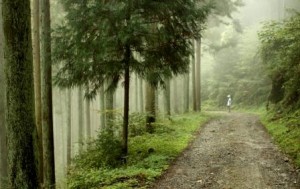
Chelsea paused on the way down from temple 60. After biking up numerous hills, the road became to steep and we had to leave our bikes and finish the trek on foot.
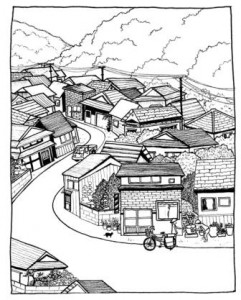
This illustration was inspired by all of the help we received along the way. Here, a woman offers the girl fresh spring water.
You can find more pictures of their journey and illustrations from their book on the JETAADC blog.
Justin’s Japan: ‘Evangelion: 3.0,’ Stanley Clarke Trio, K-pop Concert Debuts

Evangelion: 3.0 You Can (Not) Redo makes its New York theatrical debut at Big Cinemas Manhattan Jan. 10. (© khara. Licensed by FUNimation® Productions, Ltd. All Rights Reserved.)
By JQ magazine editor Justin Tedaldi (CIR Kobe-shi, 2001-02) for Examiner.com. Visit his Japanese culture page here for related stories.
Start 2014 off right by heading down to your local concert hall, cinema or arts center for some fantastic new year’s fare. Whether you enjoy cutting edge anime, a performance from Grammy-winning and pop sensations, or a classic film favorite of the legendary Donald Richie, treat yourself and catch a break from the cold.
This month’s highlights include:
Sunday, Jan. 5, 7:00 p.m.
MIKA Samba Jazz Trio
Somethin’ Jazz Club, 212 East 52nd Street, 3rd Floor
$12
Presented by Mar Creation, New York-based samba jazz pianist and recording artist MIKA will have her first concert in 2014 at midtown’s venerable Somethin’ Jazz Club, supported by Rafael Barata (drums) and Eduardo Belo (bass). A native of Rio de Janeiro, Barata brings the bossa nova, Belo brings the bottom, and MIKA knits it all together, evoking the warm, soothing sounds of Ipanema and beyond to kick off the new year in style.
Jan. 8-12
Niwa Gekidan Penino—The Room Nobody Knows
Japan Society, 333 East 47th Street
$28/$22 Japan Society members
North American debut! Two brothers inhabit a mysterious, dreamlike apartment. On the day of the elder’s birthday, the younger, who is supposed to be studying for college entrance exams, is preoccupied with creating unusual objects for the celebration. Meanwhile, in the upper room, the younger brother’s alter egos—derived from his wild imagination and taking the form of two creatures, one with a sheep’s head and another with pig features—help with the party preparations. Written and directed by psychiatrist turned most-talked-about theater artist Kuro Tanino and performed by his company Niwa Gekidan Penino, The Room Nobody Knows lures you into a weird yet funny world hidden deep within the Tokyo metropolis. Performed in Japanese with English subtitles. A MetLife Meet the Artists Reception follows the Jan. 8 performance.
Thursday, Jan. 9, 7:30 p.m.
Best Buy Theater, 1515 Broadway
$50-$180
Forming in their native South Korea in 2008 and big in Japan (where they have toured and released albums since 2011), boy band U-KISS is finally touring America for the very first time! U-KISS (an acronym for Ubiquitous Korean International Super Star) consists of members Kevin, Eli, AJ, Soohyun, Kiseop, and Hoon. The band will kick off a new series of concerts titled “THE HEADLINERS,” which promises to bring spectacular 360-degree content of these rising pop princes.
For the complete story, click here.
WIT Life #257: 今年の漢字
WIT Life is a periodic series written by professional Writer/Interpreter/Translator Stacy Smith (Kumamoto-ken CIR, 2000-03). She starts her day by watching Fujisankei’s newscast in Japanese, and here she shares some of the interesting tidbits and trends along with her own observations.
It was recently announced that the kanji representing 2013 would be 輪 (rin or wa). It means ring, circle, or wheel, and refers to different aspects that have converged this year. This was the most popular submission in the public contest run by the Japan Kanji Aptitude Testing Foundation, and there were several explanations for why. One idea came from the five rings symbolizing the Olympics, in regard to the September announcement that Tokyo would host the Summer Olympics in 2020. Another was the coming together of citizens in a circle of recovery from the Great East Japan Earthquake (Thanks to this rebuilding, construction and real estate related stocks have been booming on the Nikkei Stock Average). Yet another interpretation was the private/public cooperation that led to the recent registration of Mt. Fuji on the World Heritage List. 輪 received 9518 votes, and second-place  楽 (raku) which received 8562 votes referred to the Tohoku Rakuten (楽天) Golden Eagles’ victory in the Nippon Series baseball championship.
楽 (raku) which received 8562 votes referred to the Tohoku Rakuten (楽天) Golden Eagles’ victory in the Nippon Series baseball championship.
For those who are interested in kanji and Japanese calligraphy, I would highly recommend the current exhibit at the Metropolitan Museum of Art entitled Brush Writing in the Arts of Japan. It was interesting to learn about Read More
JQ Magazine: JQ&A with Manga Translator Zack Davisson on Shigeru Mizuki
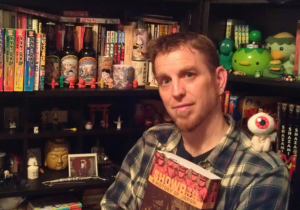
“All of JET is fond memories for me. I loved it. Kansai was the perfect area. Nara, Osaka, and Kyoto were all in easy reach so I had the best of everything. I lived in ancient and traditional Japan, but had wild and modern Japan nearby anytime I wanted. I did everything I could possibly do, went everywhere, tried everything—it changed my life.” (Courtesy of Zack Davisson)
By Julio Perez Jr. (Kyoto-shi, 2011-13) for JQ magazine. A bibliophile, writer, translator, and graduate from Columbia University, Julio is currently seeking opportunities with publications in New York. You can follow his enthusiasm for Japan, literature, and board gaming on Twitter @brittlejules.
A scholar, author and translator of Japanese folklore and ghost stories, Zack Davisson (Nara-ken, 2001-04; Osaka-shi, 2004-06) joined the JET Program in 2001 with some basic Japanese knowledge and a strong desire to learn much more. After spending five years on the program, he remained in Japan to acquire a master’s degree in Japanese studies while writing freelance and translating for Osaka University.
The theme of Japanese ghosts running through Davisson’s writing and translation dovetails the interests of manga legend Shigeru Mizuki, who is famous for the classic series GeGeGe no Kitaro. Mizuki is equally well known in Japan for his autobiographical works about his experiences as a soldier during World War II. A great fan of Mizuki, Davisson now contributes to publisher Drawn and Quarterly’s English adaptations of Kitaro and is the translator of the first volume of Mizuki’s historical manga Showa 1926-1939: A History of Japan, released last month in North America.
In this exclusive, expansive interview, Davisson discusses his time on JET, the significance of Mizuki’s supernatural and historical works, and the unique methods and madness of manga translation.
How did you first become interested in learning the Japanese language, and how long have you been studying it? For aspiring translators who are still studying, do you have any advice about textbooks, programs, or techniques?
I actually became interested when I was about 10 years old and my mother took me to see Seven Samurai at a local art theater. I was hooked pretty early—if I you look at my class pictures from that time I am wearing ridiculous Japan t-shirts. I took Japanese in high school when it was offered as a foreign language, but there were only four of us in the class, so it was cancelled—no one was interested in learning Japanese back then. This was the ’80s, so there was no “Cool Japan.” That pretty much ended my language studies for a while.
Decades later when I went on JET, I was useless language-wise. I thought I knew more Japanese than I did, but really just the set phrases and greetings. I was determined to leave JET functionally bilingual, so I just studied as hard as I could from day one, eventually getting my master’s degree in Japan.
My only real advice for people is to go to Japan, and talk and read and practice as much as humanly possible. There is no substitute for immersion and experience. I always say I learned more Japanese at my local bar, the 100 Club, than I did doing my MA. Talk, talk, talk. Read, read, read. Use Japanese as a living language, don’t just study it as an abstract. And, of course, marry a Japanese person. That’s a huge advantage!
When and where were you posted for JET? Could you talk a bit about your time there and what you remember fondly?
I started JET in…I think 2001. Crazy to think it was more than 10 years ago, because it doesn’t feel that way. I was unusual in that I was a 5-year JET that worked in two prefectures. I did three years in Nara and then two years in Osaka. I don’t know if they still allow you to do that. I was one of the first in my prefecture to get that contract extension, and even then there were only two of us allowed to do it.
As for fond memories…all of JET is fond memories for me. I loved it. Kansai was the perfect area. Nara, Osaka, and Kyoto were all in easy reach so I had the best of everything. I lived in ancient and traditional Japan, but had wild and modern Japan nearby anytime I wanted. I did everything I could possibly do, went everywhere, tried everything—it changed my life. And my career; I got started in writing and translating doing articles for my prefectural newsletter, then moved on to publishing magazine articles for Kansai Time Out and Japanzine. And now I have my Shigeru Mizuki translations out and my book, Yurei: The Japanese Ghost, coming next year. I owe all that to JET and the people I met on JET.
In what ways did you become involved in your community?
I wasn’t a big community person, other than I threw myself into every matsuri I could. I was fascinated with Shinto festivals, especially the big, loud, and dangerous ones. Anything fueled with alcohol and adrenaline. I did the Okayama Hadaka Matsuri four times and brought the magic sticks out twice. I carried this massive mikoshi in a little village in Nara every year. In Osaka, I carried these giant, flaming torches in the Taimatsu Matsuri for my town. I loved the primal nature of these matsuri, the physicality and closeness to the gods—it’s something we’ve completely lost in the U.S. In our quest for safety and comfort we’ve lost something intangible. Something Joseph Campbell would have recognized and appreciated.
Other than that, I was a regular at a local bar, the 100 Club in Osaka. A different kind of community, but that was another life changer. I’m still friends with my pals from the 100 Club and we even got matching tattoos. Not quite as sweet as volunteering at the local children’s eikaiwa, but there it is.
Justin’s Japan: Nippon in New York—Yayoi Kusama, Taka Kigawa, Taro Hakase, VAMPS

Yayoi Kusama with Love Is Calling (2013) installed as part of the artist’s inaugural exhibition I Who Have Arrived in Heaven at David Zwirner Gallery, on view through Dec. 21. (Will Ragozzino)
By JQ magazine editor Justin Tedaldi (CIR Kobe-shi, 2001-02) for Examiner.com. Visit his Japanese culture page here for related stories.
With Thanksgiving weekend (and the hopes of eating right) now just a memory, we turn to colder weather, falling snow, and the new year to come. Fortunately for Japanese culture fans, December is just as busy as the holiday season itself. Whether you’re hosting guests from out of town or looking to squeeze in an event or two in between parties, we’ve got you covered.
This month’s highlights include:
Now through Saturday, Dec. 21
Yayoi Kusama: I Who Have Arrived in Heaven
David Zwirner Gallery, 525 West 19th Street
Free
In case you missed last year’s retrospectiveat the Whitney featuring the artist’s mega-buzzed about Fireflies on the Water, this current exhibition by Yayoi Kusama features 27 new large-scale paintings and The Souls of Millions of Light Years Away, a new mirrored infinity room made especially for this exhibition and the United States debut of another infinity room, which was recently on view in Tokyo at the Mori Art Museum. Also exhibited is the artist’s video installation, entitled Manhattan Suicide Addict, that draws its title from her first semi-autobiographical novel published in 1978.
Wednesday, Dec. 4, 8:00 p.m.
Three’s Keys feat. Taka Kigawa
Klavierhaus Recital Hall, 211 West 58th Street
$15
As part of its third annual festival entitled Timbre Tantrum, Composers Concordance(“Enterprising new music organization” –New York Times) presents this all-piano production featuring Taka Kigawa (“Extraordinary pianist” –New York Times), Inna Faliks (“Signature blend of grace and raw power” –Lucid Culture) and Carlton Holmes (“Inventive” –Jazziz). Each pianist will present a 20-minute solo set of their own contemporary repertoire, including music by Shchedrin, Zhurbin, Ellington, Palkowski, Monk, and Alexander. The grand finale serves up a triple-piano suite composed by Dan Cooper, Sean Hickey, Debra Kaye, Milica Paranosic, and Gene Pritsker performed on Klavierhaus’ antique instruments, including a 19th century Pleyel.The concert will be followed by a brief reception.
Thursday, Dec. 5, 8:00 p.m.
Town Hall, 123 West 43rd Street
$49.50-$89.50
A violinist since the age of four, contemporary classical and crossover musician Taro Hakase returns to New York as part of his first-ever world tour. Entitled JAPONISM after his latest album, Hakase’s pop-infused compositions and charismatic showmanship are known to get fans dancing at his concerts. First brought to international attention following a collaboration soundtrack and a concert tour with Celine Dion in 1996, Hakase has performed before over two million people and has sold more than six million albums in Japan alone. Along with his eight piece band, Hakase brings his tour to one of New York’s most celebrated stages.
For the complete story, click here.
Justin’s Japan: J-LABO Brooklyn Opens in Park Slope
By JQ magazine editor Justin Tedaldi (CIR Kobe-shi, 2001-02) for Shukan NY Seikatsu. Visit his Examiner.com Japanese culture page here for related stories.
Since its launch in 2008, social network J-COLLABO has been working with numerous artists to make innovative Japanese-themed collaborations accessible to the public. Now it has taken the next step in its evolution with J-LABO Brooklyn, which had its pre-opening party in Park Slope last month.
“J-LABO is a place where the conventions of intercultural chemistry are challenged and the possibilities of creative collaboration and experimentation are deeply explored as a unifying effort between Japanese culture and the cultures of the world,” explained John Figueredo, marketing and PR supervisor for J-COLLABO. “Artists who gather under J-LABO can collaborate, create and implement Japanese-themed works.”
The organization now seeks to raise $40,000 to renovate J-LABO Brooklyn through crowdsourcing funds and events.
“When it is complete, J-LABO will provide a dedicated exhibition/performance space, an artist residency program, classes, and a design lab,” Figueredo said. “With these facilities as a base, J-COLLABO will provide a venue for learning and cultural exchange as well as a generator of new art and design.”
The names of all donors will be carved on a plate for display inside the venue. J-LABO’s next event is an opening reception on Dec. 7 featuring live painting by Fukuoka-based calligrapher and artist Sugita Koki preceding his newest exhibition entitled Kotokama, which will be on display through Dec. 20.
For more information, please visit www.j-collabo.org.
WIT Life #253: Preserving Japanese Traditional Arts
WIT Life is a periodic series written by professional Writer/Interpreter/Translator Stacy Smith (Kumamoto-ken CIR, 2000-03). She starts her day by watching Fujisankei’s newscast in Japanese, and here she shares some of the interesting tidbits and trends along with her own observations.
This week I had the opportunity to interpret for a Japanese delegation comprised of two groups who traveled to New York to receive the annual Tiffany Foundation Award. This award was created by the Tiffany Foundation in collaboration with the Japan Center for International Exchange (JCIE), and it recognizes non-profits that are preserving Japanese traditional arts at the national and regional community levels. This year’s recipients were the Association for the Promotion of Ipponsugi Street, located in Ishikawa Prefecture, and envisi, located in Miyagi Prefecture. They were the 6th round of winners since the award’s establishment in late 2007.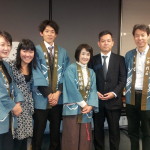
The Association for the Promotion of Ipponsugi Street, whose members are featured here wearing the happi coats, preserves their city Nanao’s unique custom of 花嫁のれん (hanayome noren). Noren are long curtains that hang in the entrances to Japanese restaurants and traditional Japanese rooms, and the special bridal ones are dyed using the Kaga yuzen technique. Hanayome noren are hung in the doorway leading to the butsuma (a small room holding sacred objects) for the bride to walk through when she gets married, a ritual that Read More
Justin’s Japan: Nippon in New York—The Legend of Zelda, Osamu Tezuka, Dir En Grey, and Hotei
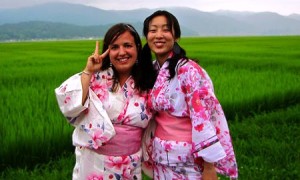
The JET Alumni Association of New York presents a special screening of Live Your Dream: The Taylor Anderson Story at Columbia University Oct. 30. (© 2012 Global Film Network. All rights reserved.)
By JQ magazine editor Justin Tedaldi (CIR Kobe-shi, 2001-02) for Examiner.com. Visit his Japanese culture page here for related stories.
From Nintendo to manga to metal to Tarantino, November is just as colorful as the blowing leaves in the air and on the ground. Add to that a Meiji era throwback exhibition at Resobox, the destroy-all-monsters vibe of Kaiju Big Battel (just in time for Turkey Day), and a world premiere at Japan Society and you’ve got an irresistibly epic rundown.
This month’s highlights include:
Wednesday, Oct. 30, 7:00 p.m.
JETAA New York presents Live Your Dream: The Taylor Anderson Story
Columbia University, Uris Hall 301
$7 advance, $10 at the door, students free with ID
Following its New York premiere at Japan Society last July, the New York chapter of the Japan Exchange and Teaching (JET) Program Alumni Association presents an encore screening of this touching documentary film about Taylor Anderson and all the young people who travel the world trying to make a difference. Taylor was an extraordinary American who dedicated herself to teaching Japanese children in the JET program, living her dream right up to the events of March 11, 2011. Includes a post-screening Q&A session with director/producer Regge Life and Taylor’s father Andy Anderson.
Friday, Nov. 1, 8:00 p.m.
The Legend of Zelda: Symphony of the Goddesses Second Quest
The Theater at Madison Square Garden
$62.50-$112.50
While F. Scott Fitzgerald famously pooh-poohed second acts, second quests are an entirely different matter. Back by popular demand and presented by Jason Michael Paul Productions, The Legend of Zelda: Symphony of the Goddesses returns to the Theater at MSG with breathtakingly new visuals and music exploring additional chapters from the Zelda franchise as well as the beautifully orchestrated four movement symphony recounting the classic storylines from some of the most popular video games in history. Take up your wooden sword and shield as a live orchestra and the Montclair State University Vocal Accord brings to life the masterpieces of legendary Nintendo composer and sound director Koji Kondo.
Thursday, Nov. 7
The Life & Works of Osamu Tezuka
Japan Society, 333 East 47th Street
$25/$20 Japan Society members, seniors and students
Best known as the creator of Astro Boy, Osamu Tezuka (1928-1989) is often credited as the “Godfather of Anime and Manga” due to his prolific output, pioneering techniques, and reimagining of genres. His work redefined Japanese cartoons, transforming them into an irresistible art form, and incorporated a variety of new styles in their creation. Leaving a lasting impact on literature and film, his work also influenced a range of other artistic genres. In this special lecture, Tezuka’s works are presented by JET alum Roland Kelts (Osaka-shi, 1998-99), author of Japanamerica. This event is moderated by NYC-based cartoonist Katie Skelly. Ticket price includes a pre-event wine and Japanese hors d’oeuvres reception.
For the complete story, click here.
JETAA New South Wales organizes uchiwa design competition for Sydney Japan Festival 2013
Posted by Eden Law of JETAA New South Wales:
To help promote the Japan Festival 2013 happening in Sydney on December 14, we folks at the JETAA New South Wales chapter have hit upon the idea of running an uchiwa design competition. As the Japan Festival takes place at the height of the Australian summer, an uchiwa seemed a logical choice as one of the cultural icons of Japan. Competitors are invited to submit a design that will decorate a thousand uchiwa, or traditional Japanese rigid fans, which will be handed out to help visitors to the festival stay cool and look cool. Some additional prizes may also be announced at a later date.
It’s been an idea that’s been percolating for a while, which we’ve able to realise thanks to the support and funding of the Sydney Japanese consulate. Part of the planning required sorting out our funding and locating a printer in Japan – anyone who’s ever been in Japan during summer would have noticed the masses of these uchiwa printed in their thousands by companies to promote and advertise everything from business services, new products to idol concerts and movies. If successful, we hope to run it next year again, and hope that it will become our unique stamp on the festival.
The competition site can be viewed at www.jetaansw.org/uchiwa-comp-page/, and runs until November 3rd 2013. Winner will be announced on our website, Facebook group (as well as the festival page) and Twitter.
Local Japan: Ehime JET alums to publish illustrated book of their 88 temple pilgrimage
Maryland-based Ehime-ken JET alums Elayna Snider and Chelsea Reidy have put together an illustrated book of their “88 temple pilgrimage” by bicycle in Shikoku. They now have a Kickstarter page to help them raise funds to publish it and a wonderful video that explains what this is all about. Definitely worth a look. It’s hard to do justice in my own words, so click the link and watch and read for yourself:
http://www.kickstarter.com/projects/1042996508/temple-by-temple
Excerpts from the Kickstarter site:
There are 88 temples on Japan’s 88 temple pilgrimage. With two bicycles, a tent, notebooks and pens, plus a Rolleiflex, we will go to all of them. While we travel the 900-mile route, we’ll be collecting the materials needed to make 88 hand-bound versions of our illustrated book, Temple by Temple.
Elayna does the art, Chelsea does the words. A children’s book? It can be. A coffee table book? Sure. A book you have around and pick up from time to time? Yes! The idea and project did not come from any prescribed place of “Let’s make a kids book.” We are two people with varying ideas and skills and we combined them to make a book that describes the route, the temples, and this 1,200 year old pilgrimage which draws people of all different faiths and from all over the world.
JQ Magazine: Book Review – ‘From Postwar to Postmodern, Art in Japan 1945-1989: Primary Documents’
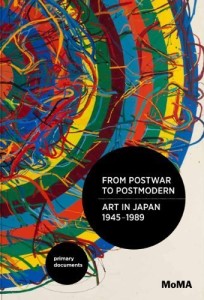
“What emerges from the multitude of ideas here is that art in Japan from this period is a visual record of repercussions that are still being felt today.” (Duke University Press)
By Jessica Sattell (Fukuoka-ken, 2007-08) for JQ magazine. Jessica is a freelance writer and a graduate student in arts journalism. She was previously the publicist for Japan-focused publishers Stone Bridge Press and Chin Music Press.
The abstract and avant-garde sculptor, painter and all-around revolutionary Japanese artist Tarō Okamoto famously said, “Art is an explostion” (geijutsu wa bakuhatsu da).
“Explosive” barely describes the energy and innovation in Japanese art in the latter half of the twentieth century. As From Postwar to Postmodern, Art in Japan 1945-1989: Primary Documents discusses, the decades between the end of World War II and the end of the Cold War marked an intensely fruitful period of groundbreaking creativity in Japan. The excitement, anxiety, and electricity that surged against the rigidity of old structures propelled Japanese art and artists into a much greater international conversation.
Published earlier this year by the Museum of Modern Art in New York and distributed by Duke University Press, this hefty tome accompanied the fall 2012-winter 2013 MoMA exhibition Tokyo 1955-1970: A New Avant Garde. There’s been a huge wave of both popular and scholarly interest in Japanese modern and contemporary art and dozens of high-profile shows at major North American museums and galleries, but the MoMA exhibit was the first to examine the “postwar” period that had been previously underrepresented. Part of this may be that the term “postwar” is tricky to define; the effects of WWII are undoubtedly still felt today and many argue that Japan is still “postwar.”
This book provides a solid foundation for an exploration of the issues and precedents leading up to the transformation of “postwar” art into the “postmodern” time. But, rather than simply rehash existing scholarship about Japanese history from 1945-1989, the book’s co-editors allow the artists, philosophers, critics and curators of this historical time to speak for themselves. The bulk of From Postwar to Postmodern includes a huge and multifaceted collection of primary source materials—personal essays, artist statements, interviews, magazine articles, interviews, critiques and manifestos—many of which have been translated into English for the very first time.





